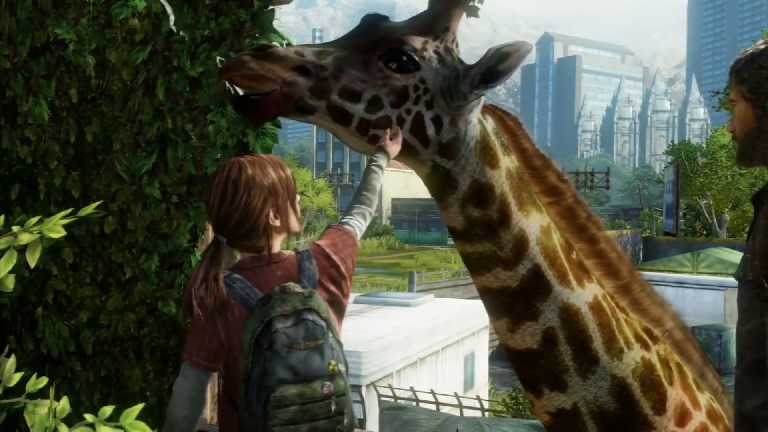Okay, my class presentation showing off The Last of Us, Bioshock Infinite, and Brothers: A Tale of Two Sons just finished. I'm counting the presentation itself and comments from the rest of the class as enough social proof to write a blog post about these moments that have inspired awe in me and want to take this opportunity to follow-up and perhaps better explain some things that weren't totally clear in the presentation itself.
To be honest, I have no idea how much awe was actually felt by members of the class as I showed them these three videogame sequences. I noticed +Carly Brown say, "That's so cool," when we solved the swimming problem in Brothers, and +Andrew Perazzo enthusiastically commented on how good the graphics looked in Bioshock. I also heard a few murmurs generally as the Salt Lake Temple first came into view in the sequence from The Last of Us. I feel like the first presentation could have been a lot more powerful if I hadn't screwed up the saved game like I did, and I sincerely apologize to everyone for the weird starting foot that put us on for the whole presentation. I'd like to take a moment to better examine each sequence and why it specifically inspires awe.
The Last of Us
After screwing up the game itself and resulting to YouTube, I stumbled through showing the instantly iconic giraffe sequence from The Last of Us. I mentioned in class the masterful subtly of this sequence as well the poignant symbolism of the giraffe walking out of the shot after Ellie takes full responsibility and the (literal) lead in going forward to find a cure and we realize Ellie childhood innocence is now totally gone and she's become an adult before her time (she's only 14). I also emphasized how breathtaking the sequence is against the backdrop of hours and hours of violence that come before it.
An aspect that I didn't discuss, but which I've already written about here, is the Neo-Romantic overtones of the scene. The whole premise of The Last of Us is an act of nature reasserting its own dominance over the planet and leaving human civilization in shambles. Remember that the original Romantic movement emphasized nature as a source of the sublime and awe-inspiring, in direct opposition to the rising industrialism of the world around the writers and artists of the movement. The Last of Us represents a kind of Neo-Romanticism in that is reasserts nature as the higher power over humanity after over a century of humanity's total dominance over the planet. While nature is shown as antagonistic to humans through the fungus, sequences like this giraffe scene show a possible new harmony between mankind and nature, and show a kind of transcendence above the fallen world through a connection with nature. The giraffe sequence is a Romantic poem for the 21st century--a hope of a reconnect with nature that will elevate us to something beyond just a constant fight for survival to a moment of peace and hope. It is a new sublime for a new Romanticism.
"Hallelujah," says a recorded voice as Booker finally penetrates the cloud cover and instantly finds himself among an impossible city in the clouds, "the closest thing to heaven" we'll get "before judgment day," as the man in the white robes says to Booker as he enters. Andrew was right to comment on the amazing graphics in the scene, as it is totally designed to be not only visually overwhelming, but audibly, mentally, and even spiritually astounding. I said in class that finding such a scene in real life would be certainly awe-inspiring, but within a videogame seems mostly just unsettling. The designers purposely use that unsettling feeling as part of their own narrative, however, as the religion depicted in the game is indeed built upon a rotten core of racism and ego. Contemplating the complexity of this emotional juggling act can create another layer of awe on top of that created by the sheer beauty of the visuals and music. Such complex authorship is indeed the future of vidoegames, and will surely help the medium find cultural legitimacy in its own right.
Brothers: A Tale of Two Sons
The point I tried to make about Brothers in class I've already made better in writing here. While the visual style and impact is understated compared to The Last of Us or Bioshock, what's so awesome (in the real sense) here is that this game finds a way to actually communicate through game mechanics. If this trick can be developed into a full-fledged language in its own right (as every year of new videogames seems to be proving), then game mechanics could become a truly new form of communication. Let alone aspiring to the status of art in our culture, this game gives us just the slightest promise that vidoegames and the unique interface between game systems and humans with controllers could become its own kind of native language apart from speech, visual art, cinema, or music. Brothers is different because it doesn't just show you the experience of a young boy remembering a lost family member and gaining strength from their continuing relationship beyond the grave, but it directly transfers that experience to the player through just a few hours of setup and a simple trick of controller buttons. It's a totally different medium and a totally different experience--and all the more powerful for that novelty. Brothers is a promise that there are somethings that vidoegames can say about the human experience that other mediums simply cannot. As I said in class, my working definition of awe is the moment where you see a gap between your perceived realm of the possible and some reality beyond it. If an entirely new ways for humans to communicate with each other doesn't cause one of those moments, I don't know what does.




No comments:
Post a Comment